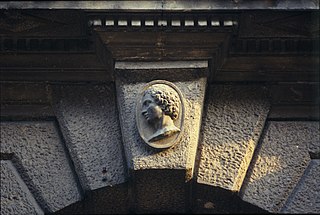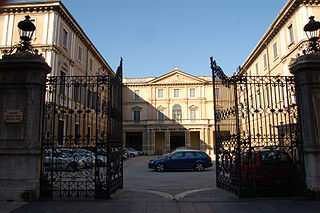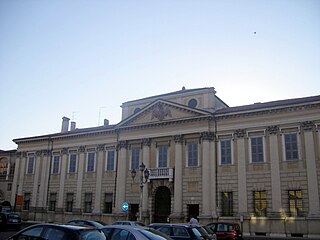
Mantua is a city and comune in Lombardy, Italy, and capital of the province of the same name.

The Duchy of Mantua was a duchy in Lombardy, Northern Italy. Its first duke was Federico II Gonzaga, member of the House of Gonzaga that ruled Mantua since 1328. The following year, the Duchy also acquired the March of Montferrat, thanks to the marriage between Gonzaga and Margaret Paleologa, Marchioness of Montferrat.

Michele Sanmicheli (1484–1559), was a Venetian architect and urban planner of Mannerist-style, among the greatest of his era. A tireless worker, he was in charge of designing buildings and religious buildings of great value.

The Palazzo Ducale di Mantova is a group of buildings in Mantua, Lombardy, northern Italy, built between the 14th and the 17th century mainly by the noble family of Gonzaga as their royal residence in the capital of their Duchy. The buildings are connected by corridors and galleries and are enriched by inner courts and wide gardens. The complex includes some 500 rooms and occupies an area of c. 34,000 m2, which make it the sixth largest palace in Europe after the palaces of the Vatican, the Louvre Palace, the Palace of Versailles, the Royal Palace of Caserta and the Castle of Fontainebleau. It has more than 500 rooms and contains seven gardens and eight courtyards. Although most famous for Mantegna's frescos in the Camera degli Sposi, they have many other very significant architectural and painted elements.

Palazzo Mozzi or Palazzo de' Mozzi is an early Renaissance palace, located at the end of the Piazza de' Mozzi that emerges from Ponte alle Grazie and leads straight to the palace where via San Niccolò becomes via de' Bardi in the Quartiere of Santo Spirito in the Oltrarno section of Florence, region of Tuscany, Italy. The 13th-century palace housed the gallery of the highly successful antiquarian Stefano Bardini, of which the remnants were left to the commune, where they assembled the Museo Bardini or Mozzi Bardini, displaying Florentine art and artifacts up to the early Renaissance. The gardens elaborated against the hillside behind the palace were added mainly by Bardini.

Magdalena di Canossa was an Italian professed religious and foundress of the two Canossian congregations. Magdalena was a leading advocate for the poor in her region after she witnessed first hand the plight of the poor following the spillover effects of the French Revolution into the Italian peninsula through the Napoleonic invasion of the northern territories. Canossa collaborated with humanitarians such as Leopoldina Naudet and Antonio Rosmini in her mission of promoting the needs of the poor and setting a new method of religious life for both men and women.

The Royal Palace of Turin is a historic palace of the House of Savoy in the city of Turin in Northern Italy. It was originally built in the 16th century and was later modernized by Christine Marie of France (1606–1663) in the 17th century, with designs by the Baroque architect Filippo Juvarra. The palace also includes the Palazzo Chiablese and the Chapel of the Holy Shroud, the latter of which was built to house the famous Shroud of Turin.

Bernardino India (1528–1590) was an Italian painter of the late Renaissance, born and mainly active in Verona. He is said to have trained with Domenico Riccio. He collaborated with Michele Sanmicheli in the Canossa palace and Pellegrini chapel in San Bernardino of Verona. He collaborated with Felice Brusasorci, Domenico's son in frescoes at Palazzo Fiorio Della Seta. He decorated Palladian villas such as Villa Pojana, Villa Foscari where Giovanni Battista Zelotti also worked, and the Palazzo Thiene in Vicenza. Orlando Flacco completed his most extensive work for the Sala Maggior di Consiglio in Verona.

The Castel Vecchio Bridge or Scaliger Bridge is a fortified bridge in Verona, northern Italy, over the Adige River. The segmental arch bridge featured the world's largest span at the time of its construction.

The Giusti Palace and Garden are located in the east of Verona, Italy, a short distance from Piazza Isolo and near the city centre. The palace was built in the sixteenth century. The garden is considered one of the finest examples of an Italian garden.
Adriano Cristofali was a Veronese architect, whose style bridged between Enlightenment-Baroque architecture and Neoclassicism.

Palazzo Dalla Torre is a patrician palace in Verona, northern Italy, designed by Italian Renaissance architect Andrea Palladio for Giambattista Dalla Torre. The palazzo was probably built from 1555, but remained unfinished. Allied bombardment in 1945 demolished a great part of the building. However, conspicuous remains of Palladio’s construction survive: the majestic access portal and a courtyard with columns and entablature.

Palazzo Maffei is a historical palace in Verona, northern Italy, on the north-western side of Piazza delle Erbe.

The Palazzo Michiel Dalle Colonne is a Baroque style palace located on the northern bank of the Grand Canal in the sestiere of Cannaregio in Venice, Italy. It is one building south of the junction of Rio del Santissimi Apostoli with Grand Canal, next to the Palazzo Michiel del Brusà and across the Canal from the Rialto Mercato and the Campo della Pescaria. The palace is also referred to as Palazzo Michiel Dalle Colonne a Santa Sofia.

The Palazzo Manfrin Venier, once known as the Palazzo Priuli a Cannaregio or Palazzo Priuli Manfrin, is a Baroque-style palace located facing the Cannaregio Canal in the sestiere of Cannaregio of Venice, Italy. It stands to the left of the Palazzo Savorgnan.

The Church of the Santissima Trinità is a Romanesque style, Roman Catholic church in Verona, region of Veneto, Italy.

The Palazzo Miniscalchi, adjacent to the 19th-century, Neoclassic style Palazzo Miniscalchi-Erizzo located on via Garibaldi, is a late-Gothic style palace with a facade on Via San Mamaso in central Verona, region of Veneto, Italy. The palace presently houses a museum and the Foundation for the Miniscalchi-Erizzo Museum. Access to the museum is through the Via San Mamaso entrance.

The Palazzo D'Arco is a Neoclassical-style palace located on Piazza Carlo D'Arco #4 in Mantua, region of Lombardy, Italy. The palace houses the Museo di Palazzo d'Arco, which displays the furnishings and artwork collected by the Duke D'Arco.
The following is a timeline of the history of the city of Verona in the Veneto region of Italy.
Canossa is a town in Italy.

















